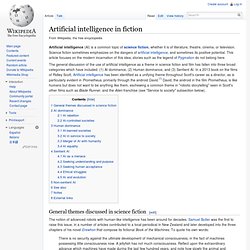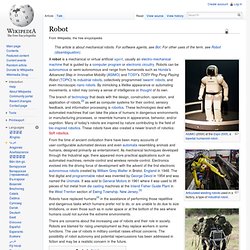

Know_your_paradoxes.png (1370×764) Three Laws of Robotics - Asimov. Failure causes. . . . That Thou Art Mindful of Him. ". . .

That Thou Art Mindful of Him" (also signed as "—That Thou Art Mindful of Him") is a science fiction short story by Isaac Asimov, which he intended to be an "ultimate" probe into the subtleties of his Three Laws of Robotics. The story first appeared in the May 1974 issue of Fantasy and Science Fiction and the 1974 anthology Final Stage, edited by Edward L. Ferman and Barry Malzberg. The Bicentennial Man. According to the foreword in Robot Visions, Asimov was approached to write a story titled "Bicentennial Man" for a science fiction collection, along with a number of other authors who would do the same, in honor of the bicentennial of the United States.

However, the arrangement fell through, leaving Asimov's the only story actually completed for the project. Asimov sold the story to Judy-Lynn del Rey, who made some small changes to the text. Android (robot) An android is a robot[1] or synthetic organism[2][3][4] designed to look and act like a human, especially one with a body having a flesh-like resemblance.[2] Until recently, androids have largely remained within the domain of science fiction, frequently seen in film and television.

However, advancements in robot technology have allowed the design of functional and realistic humanoid robots.[5] The word was coined from the Greek root ἀνδρ- 'man' and the suffix -oid 'having the form or likeness of'.[6] The Oxford English Dictionary traces the earliest use (as "Androides") to Ephraim Chambers' Cyclopaedia, in reference to an automaton that St. Authors have used the term android in more diverse ways than robot or cyborg. Eric G. The Intelligent Robotics Lab, directed by Hiroshi Ishiguro at Osaka University, and Kokoro Co., Ltd. have demonstrated the Actroid at Expo 2005 in Aichi Prefecture, Japan. Artificial intelligence. AI research is highly technical and specialized, and is deeply divided into subfields that often fail to communicate with each other.[5] Some of the division is due to social and cultural factors: subfields have grown up around particular institutions and the work of individual researchers.

AI research is also divided by several technical issues. Some subfields focus on the solution of specific problems. Others focus on one of several possible approaches or on the use of a particular tool or towards the accomplishment of particular applications. The central problems (or goals) of AI research include reasoning, knowledge, planning, learning, natural language processing (communication), perception and the ability to move and manipulate objects.[6] General intelligence is still among the field's long-term goals.[7] Currently popular approaches include statistical methods, computational intelligence and traditional symbolic AI.
History[edit] Research[edit] Goals[edit] Planning[edit] Logic-based. Artificial intelligence in fiction. The general discussion of the use of artificial intelligence as a theme in science fiction and film has fallen into three broad categories which have included: (1) AI dominance, (2) Human dominance, and (3) Sentient AI.

In a 2013 book on the films of Ridley Scott, Artificial intelligence has been identified as a unifying theme throughout Scott's career as a director, as is particularly evident in Prometheus, primarily through the android David.[1] David, the android in the film Prometheus, is like humans but does not want to be anything like them, eschewing a common theme in "robotic storytelling" seen in Scott's other films such as Blade Runner, and the Alien franchise (see "Service to society" subsection below). General themes discussed in science fiction[edit] There is no security against the ultimate development of mechanical consciousness, in the fact of machines possessing little consciousness now.
A jellyfish has not much consciousness. Artificial intelligence in fiction. Robot. The branch of technology that deals with the design, construction, operation, and application of robots,[2] as well as computer systems for their control, sensory feedback, and information processing is robotics.

These technologies deal with automated machines that can take the place of humans in dangerous environments or manufacturing processes, or resemble humans in appearance, behavior, and/or cognition. Many of today's robots are inspired by nature contributing to the field of bio-inspired robotics. These robots have also created a newer branch of robotics: Soft robotics. Three Laws of Robotics. This cover of I, Robot illustrates the story "Runaround", the first to list all Three Laws of Robotics. A robot may not injure a human being or, through inaction, allow a human being to come to harm.A robot must obey the orders given to it by human beings, except where such orders would conflict with the First Law.A robot must protect its own existence as long as such protection does not conflict with the First or Second Law.[1] The original laws have been altered and elaborated on by Asimov and other authors.
Asimov himself made slight modifications to the first three in various books and short stories to further develop how robots would interact with humans and each other. In later fiction where robots had taken responsibility for government of whole planets and human civilizations, Asimov also added a fourth, or zeroth law, to precede the others: 0. Three Laws of Robotics. Kara : a PS3 new technology.